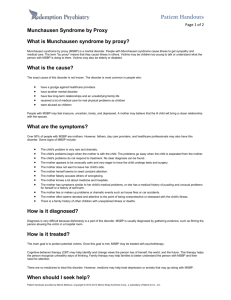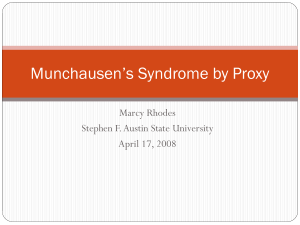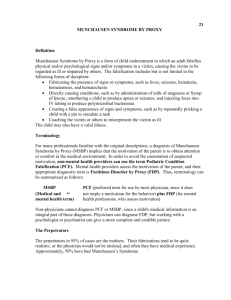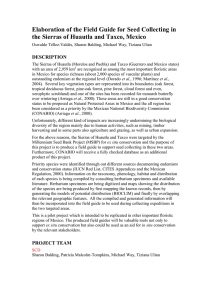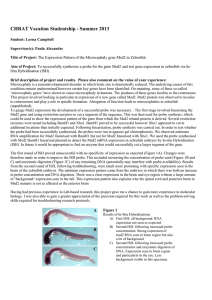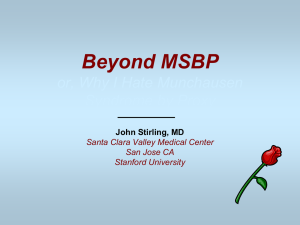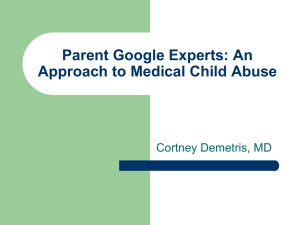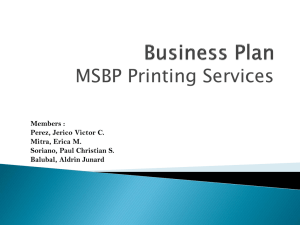Munchausen Syndrome by Proxy
advertisement
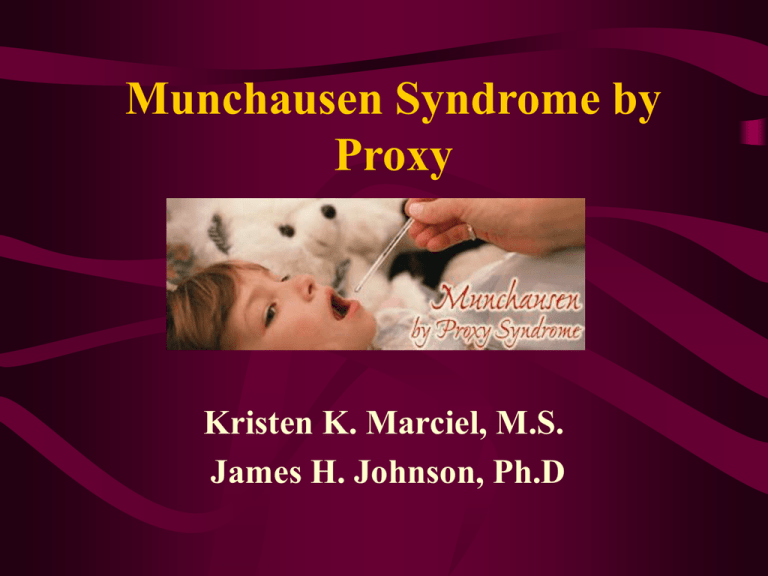
Munchausen Syndrome by Proxy Kristen K. Marciel, M.S. James H. Johnson, Ph.D Who was Munchhausen? • Baron von Munchhausen (1720 – 1797) • German, retired officer of Russian cavalry • Fond of recounting exploits from war • Age 74, married 17-year-old – Wedding night spent alone – Wife gave birth to a baby – Infant died at 1 year under “suspicious circumstances” Munchausen Syndrome • 1877 Charcot’s “mania operativa passiva” – Treatment for self-inflicted or falsified injuries • 1951 Dr. Richard Asher’s “Munchausen Syndrome” – Fabricated illness, traveled from doctor to doctor – Complex medical investigations/procedures Definition of MSBP • First highlighted by British Pediatrician, Roy Meadow, and described in a number of publications (1977,1982, 1985) • A condition in which a parent or other caretaker persistently fabricates symptoms on behalf of another, causing that person to be regarded as ill (Meadow, 1985) • Considered a type of abuse as the behaviors of the perpetrator (usually the mother) can result in the child having to undergo invasive medical tests and receive treatments that may be harmful The Nature of the Problem • The nature of the problem can be best highlighted by considering characteristics of 19 cases initially described by Meadow (1982) • 10 boys, 9 girls • Mean age 3 years, 2 months • Children displayed wide range of symptoms, typically suggestive of a “multisystem disorder” Case Characteristics: Summary • False symptoms had persisted on average 13 months prior to diagnosis • Most had been seen by numerous doctors, had been referred from hospital to hospital – one had been examined by 28 consultants • In each case the mother was the source of the fraudulent history and the fabricator of false symptoms Case Characteristics: Summary • False histories provided by mothers were “impressive in medical detail and fabricated symptoms were often quite realistic” • Meadow notes that “the methods used combined cunning, dexterity, and, quite often, medical knowledge” • It is noteworthy that the perpetrators were, not infrequently, individuals with some medical knowledge Case Characteristics: Summary • Bleeding – generally the result of mother adding her own blood to the child’s vomit, urine, and feces – (Have seen one case here where mother put her own blood in child’s feces) – In one instance feces were mixed with the child’s vomit to cause abnormal findings • Fevers – often produced by rubbing thermometer or immersing it in hot liquids • Biochemical Chaos – often resulted from diluting or adding chemicals, such as salt, to blood specimens Case Characteristics: Summary • Rashes – fabricated by rubbing the skin, by adding caustic solutions to skin, or by painting the skin with some sort of dye • Neurological Symptoms – generally the result of the mother giving the child drugs (sedatives or tranquilizers) that had been prescribed for herself • Fabricated symptoms led to a range of unnecessary procedures including many medical procedures and long and expensive hospital stays Symptom Categories 1. Exaggerations – 2. Claim migraines when child has headaches False reports – 3. Falsely claim child has seizures Falsification of signs – 4. Parent alters child’s urine sample Simulations of signs/symptoms – 5. Child taught to fake seizures Dissimulations – 6. Allow real illness to progress Aggravations – 7. Rub dirt in child’s laceration Self-induced signs/symptoms – Parent injects child with bacteria Case Characteristics: Summary • Seven of the 19 mothers had a history of Munchausen’s syndrome themselves • In two families, a sibling was also involved in the mothers fabricating of symptoms • Most carried no diagnostic label and were seen by medical staff as caring and loving of their children Medical Procedures Incurred • Six year old boy – Missed 13 months of school, 1 month of IV fluids, and a range of other procedures such as lumbar puncture, EEG, and brain scans • Also had bone, kidney, and skin biopsies as well as being prescribed a range of drugs including antibiotics, steroids and ~ 20 other medications Hints of Potential Contributors • Meadow notes “It would be naïve to seek a single cause for the harmful behaviors for these mothers” • For some, the child’s illness brought about a closer relationship with the husband, while for others, it seemed to provide a welcome distraction from personal and home difficulties • Several mothers thrived on the children’s wards They seemed to love it, bustling around helping other mothers, helping the nurses, and forming close relationships with junior medical staff • They made the medical staff feel that the pediatric service was really good Hints of Potential Contributors • For some it seemed to be a bizarre game in which they matched themselves against the best specialists and the best hospitals the could find • Several of these mothers were individuals with prior training in nursing • Based on observations made in working with these cases, Meadow has presented a number of tentative “warning signs” that may be helpful in making an earlier diagnosis than would otherwise be possible Possible Warning Signs • An illness that is unexplained, prolonged, and so extraordinary that it prompts experienced colleagues to state that “they have never seen anything like it before” • Symptoms and signs are inappropriate or incongruous • Symptoms only when the mother is present • Treatments that are ineffective or poorly tolerated • Children who are alleged to be allergic to a great variety of foods and drugs • Mothers who are not as worried by the child’s illness as are nurses and doctors Possible Warning Signs • Mothers are constantly with their ill child and will not leave the ward, for even brief periods of time • Families where sudden unexplained infant deaths have occurred and families with many members who are alleged to have serous medical disorders • Symptoms of a very rare disorder (although children can have rare disorders) • Seizures that do not respond to carefully administered anticonvulsants • Note that these are simply “signs” that warrant being more watchful as they many of them may also be associated with other health related factors Facts About MSBP From Lasher and Feldman (2001) • MSBP is dangerous – It has been estimated that 6 to 10 percent of MBP victims die • MSBP is a recognized kind of maltreatment (abuse/neglect) • MSBP perpetrators deliberately engage in MSBP behavior • Cases that appear to involve only false reports or simulation of symptoms should be considered as dangerous as those in which induction of illness has been suspected or confirmed Epidemiology (From Huynh, 1998) • Determining the incidence and prevalence of MSBP is difficult for a variety of reasons • No population-based studies have been conducted • The true incidence of MSBP is hard to assess because many cases go undetected • Often, there are case suspicions, but insufficient evidence exists or is gathered, so these cases are never officially reported or investigated • Furthermore, the diagnosis of MSBP takes time; average time for diagnosis ranges from 6 to 15 months (Parnell, Day, 1997) Epidemiology: Some Tentative Findings • Estimated 2-4 cases per million in the general population (Alexander et al., 1990) • Of the 2.5 million cases of child abuse reported annually, 1000 are related to MSBP (Volz, 1995) • Fatality rate for MSBP is approximately 10% – 6% died, 25% siblings (Sheridan, 2003) • Physical morbidity rate of 75%; possibly even higher psychological morbidity rate (Rosenberg, 1987) Epidemiology: Some Tentative Findings • Boys and girls are equally affected, and all socioeconomic classes are represented – 52% males, 48% females • 79% Caucasian • Average age of onset 48 months • 6% dead, 7% long-term injury – Most common symptom of dead victims – apnea (Sheridan, 2003) • 25% to 35% of the time, MSBP is perpetrated serially on siblings (Alexander et al., 1990) Epidemiology: Some Tentative Findings • Most perpetrators assume the “mother” role; 77-90% are biological mothers • 5-6% include the father, babysitter, nanny, or grandmother (Meadow, 1985) • Characteristics – – – – 29% symptoms of Munchausen Syndrome 22% history of childhood abuse 27% history of working in healthcare 23% psychological disorders, such as Personality D/O, NOS; Depression; Borderline PD, Paranoia (Sheridan, 2003) MSBP Outcome: Some Tentative Findings (From Huynh, 1998) • Currently, there is limited data available on child victims of MSBP despite increased awareness (Bools et al, 1993); very few follow-up studies • As many as 10% may die as a result of induction of illness or from diagnostic interventions • May develop chronic invalidism • Can experience permanent disfigurement from medical procedures MSBP Outcome: Some Tentative Findings (From Huynh, 1998) • Develop permanent impairment of bodily function from the medical procedures • Child may show academic delays from “chronic absenteeism,” and problems with concentration, emotions, and behaviors (Libow, 1994) • Child may show delays in social development from lack of age-appropriate interaction with peers and adults • Risk of perpetration of MSBP on their own child(ren) as an adult MSBP Outcome: Some Tentative Findings (From Huynh, 1998) • Child may develop disturbed understanding of proper mother-child relationship • The child may develop significant adjustment problems • In general, it seems that the prognosis is likely to be quite poor • Although many children return to the family and survive, there is no convincing case in the professional literature demonstrating successful treatment DSM Criteria • Munchausen’s Syndrome by Proxy – – • Located in Appendix B of DSM-IV-TR Criteria sets/axes provided for further study Factitious Disorder by Proxy A. Intention production or feigning of physical or psychological signs or symptoms in another person who is under the individual’s care B. The motivation to assume sick role by proxy C. External incentives (e.g., economic gain) are absent D. Behavior not better accounted for by other mental disorder Differential Diagnoses • Factitious Disorder by Proxy • Malingering by Proxy – Abuse to accrue tangible benefits, such as financial compensation • Munchausen Syndrome • Factitious Disorder – Both of these ARE mental disorders – Disorders involving fabricated/simulated diseases – Motivation is psychological payoff nurturance, no apparent external incentive – MS more severe form of FD Sexual Abuse Allegations as Munchausen by Proxy • Given the sexual abuse allegations made by this parent, note that professionals have highlighted the fact that this can be a contemporary variation on Munchausen Syndrome by Proxy • Goodwin (1982) and Wakefield and Underwager (1988) have cited examples of this type of MSBP (e.g., use of tampons to create physical findings) • Lasher and Feldman (2001) have authored an article having to do specifically with this variation http://childabuse.gactr.uga.edu/both/lasherfeldman/lasherfeldman1.phtml Sexual Abuse Allegations as Munchausen by Proxy • It should be noted that, this variation on Muchausen by Proxy can in fact represent sexual abuse itself in some instances • In cases where there are repeated allegations, the repeated physical evaluations resulting from these claims may represent a type of abuse by proxy • One also wonders about the contribution of this type of MSBP to “false memories” Enhancing Detection • Positive separation test • Analysis of previous medical course – Temporal relationship between mother and illness • • • • • Overt / Covert video monitoring Station nurse near hospital room Perform specialized testing Ask the child Psychological consultation! Dr. Johnson’s case example Psychology Clinic Case: An Interdisciplinary Team Approach • Specially called health care meeting attended by total of 12 professionals – – – – – – Private practice pediatricians Shands Pediatricians (Continuity of Care) Child Protection Team members Psychologist (that would be me!) Social Workers Staff from the Nurturing Program Reasons the Meeting • Meeting was prompted by a referral from ENT • Related to a recent hospitalization of a 15-month-old male who had tubes placed in ears and an adenoidectomy • Was sent home when deemed appropriate, with mom being very upset – thought it was too early for him to be discharged, was put on extra fluids • Mom called indicating that he would not take fluids, was dehydrated, was having seizures, and DEMANDED that he be hospitalized • No evidence of either dehydration or seizures was found… Data Suggestive of MSBP • Call from mother indicating that was child running, fell and head head – Mother reports that child had a subdural hematoma • No medical evidence was found • Call from mother indicating that child fell and hit head – Call was made 4 hours after presumed fall with mother indicating that child had fluid draining from ears • Child was air lifted to Shands – No evidence of fluid or any serious injury • Alleged that child swallowed Christmas tree bulb – No bulb was found Data Suggestive of MSBP • Mother took child for immunization – Child bite marks found – Nurse practitioner finds bruising in the area of the genitals and questions mother – Later mother ends up at ER stating that child was bitten by Brown Recluse spider • Child’s 5 year old sister repeatedly taken to physician with claims that she had been sexually abused by her father, the mothers ex-husband, when child had gone to visit • Allegations resulted in child undergo multiple examinations with no physical findings being noted and mother continuing to allow visits Other Data Suggestive of MSBP • By age 15 months the younger child had experienced: – – – – 4 hospitalizations at 2 different hospitals 9 emergency room visits 52 total medical visits 81 call slips were documented by one private practice pediatrician – Child had also been seen by Shands pediatrics after original pediatrician told mom they would not continue to see child unless mother became involved in counseling Team Meeting Conclusions • It was determine that strong support existed for Munchausen’s by Proxy • It was concluded that the mother fabricated physical symptoms for the 15 month old boy • Both children were removed from the home • Mother had also fabricated allegations of sexual abuse for her 5-year-old daughter Kristen’s case example Case description • • • • 14-year-old Caucasian female Presented with severe hypoglycemia Refused to show legs and abdomen Family history of diabetes – Grandparent – insulin dependent – Mother taught her to check blood sugar • Chaotic home environment Case example • • • • • • Adolescent dropped off at hospital No hypoglycemic episodes Mother allegedly brought insulin to hospital Hypoglycemic episode occurred Overt video monitoring Observation of self-induced symptoms Questions??
